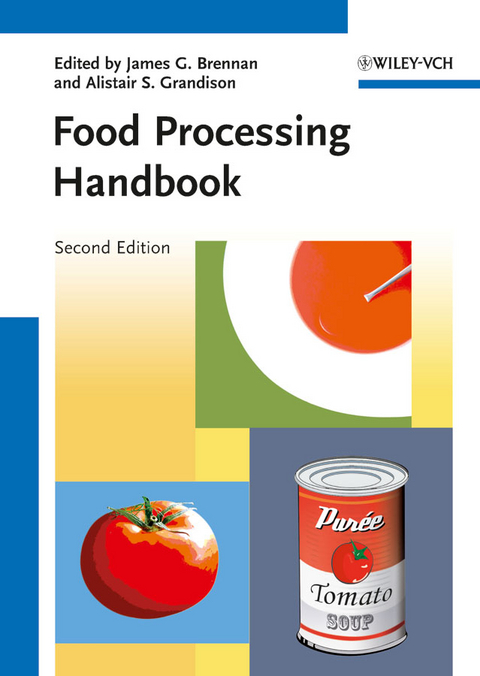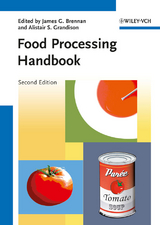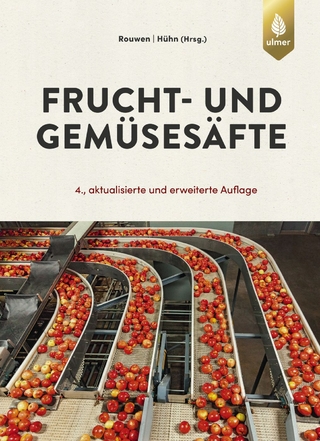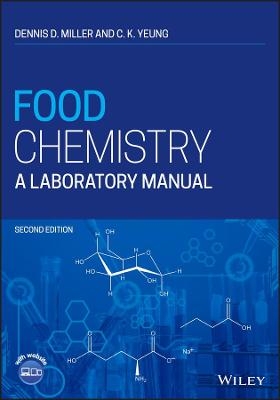Food Processing Handbook
Wiley-VCH (Verlag)
978-3-527-32468-2 (ISBN)
Completely revised and updated edition plus 35% new content.
9 new chapters, including on topical issues such as Traceability & Hygienic Design and the newest innovations, i.e. Emerging Technologies, Use of Enzymes and Nanotechnology in Food Processing.
Dieses technologisch orientierte Handbuch beschäftigt sich mit allen Aspekten der Konservierung und Verarbeitung von Lebensmitteln. Ausführlich besprochen werden physikalische, chemische, mikrobiologische und organoleptische Veränderungen der Nahrungsmittel nach der Ernte, während der Zubereitung oder Verarbeitung, beim Packen und Lagern. Der zweite Teil des Bandes beschäftigt sich unter anderem mit Grundoperationen wie Mischen und Emulgieren, mit umweltbezogenen Aspekten (etwa der Abwasserbehandlung) und mit Fragen der Sicherheit (Reinigung, Hygiene).
James G. Brennan qualified with a BSc(Hons) degree in Dairy Science from University College Cork, Ireland, in 1959. In 1960 he obtained an MSc degree, by research, in the same subject. Following a short spell in industry he moved to the National College of Food Technology (NCFT), Weybridge, UK, to undertake a postgraduate course in Food Technology. On successful completion of that course he joined the academic staff of NCFT. In 1966 NCFT became part of the University of Reading. In 1982 NCFT moved from Weybridge to the main University of Reading campus. Mr Brennan continued as a member of the academic staff of the University of Reading until his retirement in 2002, completing over forty years of service. His teaching interests were mainly in food dehydration, food packaging and separation operations. His research interests were in the fundamentals of dehydration and physical/textural properties of foods and their measurement. He supervised over twenty PhD students and published well over one hundred research and technical papers. He is author of a book on food dehydration and coauthor with three colleagues of a well known book on food engineering operations. He edited and contributed material to the first edition of this book. He also collaborated with industry in a number of projects. Together with his wife, Anne, he travelled widely during his career including extended stays teaching and researching in Australia and the USA. In retirement he continues to write, edit and review papers and books in his field. Alistair S. Grandison qualified with a BSc (Hons) in Biochemistry from the University of Liverpool in 1973 and a PhD from the same university in 1976. Following a short spell at the Royal Liverpool Hospital he moved to the National Institute for Research in Dairying where he worked on cheese and dairy products. In 1987 he moved to the University of Reading as a lecturer. He is currently a Senior Lecturer in the Department of Food and Nutritional Sciences where his teaching interests include dairy science and food processing in general. His research has covered many aspects of dairy science and technology including the lactoperoxidase system, separation processes and the coagulation of milk and manfacture of dairy products, frequently involving industrial collaboration. He has supervised 25 PhD students and published around 150 research papers, edited one book and written a number of book chapters.
VOLUME 1:
POSTHARVEST HANDLING AND PREPARATION OF FOODS FOR PROCESSING
Introduction
Properties of Raw Food Materials and Their Susceptibility to Deterioration and Damage
Storage and Transportation of Raw Materials
Raw Material Cleaning
Sorting and Grading
Blanching
Sulfiting of Fruits and Vegetables
THERMAL PROCESSING
Introduction
Reaction Kinetics
Temperature Dependence
Heat Processing Methods
Special Problems with Viscous and Particulate Products
Ohmic Heating
Filling Procedures
Storage
EVAPORATION AND DEHYDRATION
Evaporation
Dehydration (Drying)
FREEZING
Introduction
Refrigeration Methods and Equipment
Low Temperature Production
Freezing Kinetics
Effects of Refrigeration on Food Quality
IRRADIATION
Introduction
Principles of Irradiation
Equipment
Safety Aspects
Effects on the Properties of Food
Detection Methods for Irradiated Foods
Applications and Potential Applications
HIGH PRESSURE PROCESSING
Introduction
Effect of High Pressure on Microorganisms
Ingredient Functionality
Enzyme Activity
Foaming and Emulsification
Gelation
Organoleptic Considerations
Equipment for HPP
Pressure Vessel Considerations
Current and Potential Applications of HPP for Foods
EMERGING TECHNOLOGIES FOR FOOD PROCESSING
Introduction
Pulsed Electric Field Processing
Ultrasound Power
Other Technologies
Conclusions
PACKAGING
Introduction
Factors Affecting the Choice of a Packaging Material and/or Container for a Particular Duty
Materials and Containers Used for Packaging Foods
Modified Atmosphere Packaging
Aseptic Packaging
Active Packaging
Intelligent Packaging
The Role of Nanotechnology in Food Packaging
VOLUME 2:
SEPARATIONS IN FOOD PROCESSING PART 1
Introduction
Solid-Liquid Filtration
Centrifugation
Solid-Liquid Extraction (Leaching)
Distillation
Crystallization
SEPARATIONS IN FOOD PROCESSING: PART 2 - MEMBRANE PROCESSING, ION EXCHANGE, AND ELECTRODIALYSIS
Membrane Processes
Ion Exchange
Electrodialysis
MIXING, EMULSIFICATION, AND SIZE REDUCTION
Mixing (Agitation, Blending)
Emulsification
Size Reduction (Crushing, Comminution, Grinding, Milling) of Solids
BAKING
Introduction
The Key Characteristics of Existing Bakery Product Groups
Bread Making
The Manufacture of Cakes
Biscuit and Cookie Making
The Manufacture of Pastry Products
EXTRUSION
General Principles
Extrusion Equipment
Effects of Extrusion on the Properties of Food
FOOD DEEP-FAT FRYING
General Principles
Effect of Deep-Fat Fried Food on Human Health
Oil Absorption in Deep-Fat Fried Food
Deep-Fat Frying Equipment
French Fries, Potato Chips, and Fabricated Chips Production
SAFETY IN FOOD PROCESSING
Introduction
Safe Design
Prerequisite Programs
HACCP, the Hazard Analysis and Critical Control Point System
Ongoing Control of Food Safety in Processing
TRACEABILITY IN FOOD PROCESSING AND DISTRIBUTION
What is Traceability?
Traceability and Legislation
Traceability and International/Private Standards
Traceability and Private Standards
Traceability in the Food Supply Chain
Product Identification
Management of Traceability Information
The Traceability System
Examples of Traceability Systems
THE HYGIENIC DESIGN OF FOOD PROCESSING PLANT
Introduction
Engineering Factors Influencing Hygiene
Hygienic Equipment Design
Process Design
Process Operation and Control
Future Trends
Conclusions
PROCESS CONTROL IN FOOD PROCESSING
Introduction
Measurement of Process Parameters
Control Systems
Process Control in Modern Food Processing
Concluding Remarks
ENVIRONMENTAL ASPECTS OF FOOD PROCESSING
Introduction
Waste Characteristics
Wastwater Processing Technology
Resource Recovery from Food Processing Wastes
Environmental Impact of Packaging Wastes
Refrigerants
Energy Issues Related to the Environment
Life Cycle Assessment
Calculating Greenhouse Gas Emissions
WATER AND WASTE TREATMENT
Introduction
Fresh Water
Wastewater
Sludge Disposal
Final Disposal of Wastewater
PROCESS REALISATION
Synopsis
Manufacturing Design
Process and Plant Design
Process Economics-Investment Criteria
Determining and Improving Process Performance
Variation
Brief Introduction to Lean and Waste
Tools for Continuous Improvement
MICROSCOPY TECHNIQUES AND IMAGE ANALYSIS FOR THE QUANTITATIVE EVALUATION OF FOOD MICROSTRUCTURE
Introduction
Microstructure, Nanostructure, and Levels of Structure
Microscopy Techniques
Image Analysis
Applications of Microscopy and Image Analysis Techniques
Concluding Remarks
NANOTECHNOLOGY IN THE FOOD SECTOR
Introduction
The Driving Force for Nanotechnology Development
Manufacture of Nanosystems: General Principles
Nanotechnology and Food
Delivery Systems for Functional Food Ingredients
Application of Nanotechnology in Food Packaging and Other Contact Surfaces
Other Areas of Application
Potential Health and Safety Concerns Involved with Ingestion of Nanoparticulates
Regulatory Aspects
Recent Initiatives
FERMENTATION AND THE USE OF ENZYMES
Introduction
Fermentation Theory
Fermented Foods
Enzyme Technology
| Erscheint lt. Verlag | 16.11.2011 |
|---|---|
| Sprache | englisch |
| Maße | 170 x 240 mm |
| Gewicht | 1866 g |
| Themenwelt | Technik ► Lebensmitteltechnologie |
| Weitere Fachgebiete ► Land- / Forstwirtschaft / Fischerei | |
| Schlagworte | Biotechnologie i. d. Chemie • Biotechnology • chemical engineering • Chemie • Chemische Technik • Chemische Verfahrenstechnik • Chemistry • Food Science & Technology • Food Science & Technology • Gastronomiebetrieb u. -management • Hospitality • Hotelgewerbe, Gastronomie u. Touristik • Industrial Chemistry • Lebensmittelforschung u. -technologie • Lebensmitteltechnik • Lebensmitteltechnologie • Lebensmitteltechnologie; Handbuch/Lehrbuch • Restaurant & Food Service Management • Restaurant & Food Service Management • Technische u. Industrielle Chemie |
| ISBN-10 | 3-527-32468-2 / 3527324682 |
| ISBN-13 | 978-3-527-32468-2 / 9783527324682 |
| Zustand | Neuware |
| Haben Sie eine Frage zum Produkt? |
aus dem Bereich




